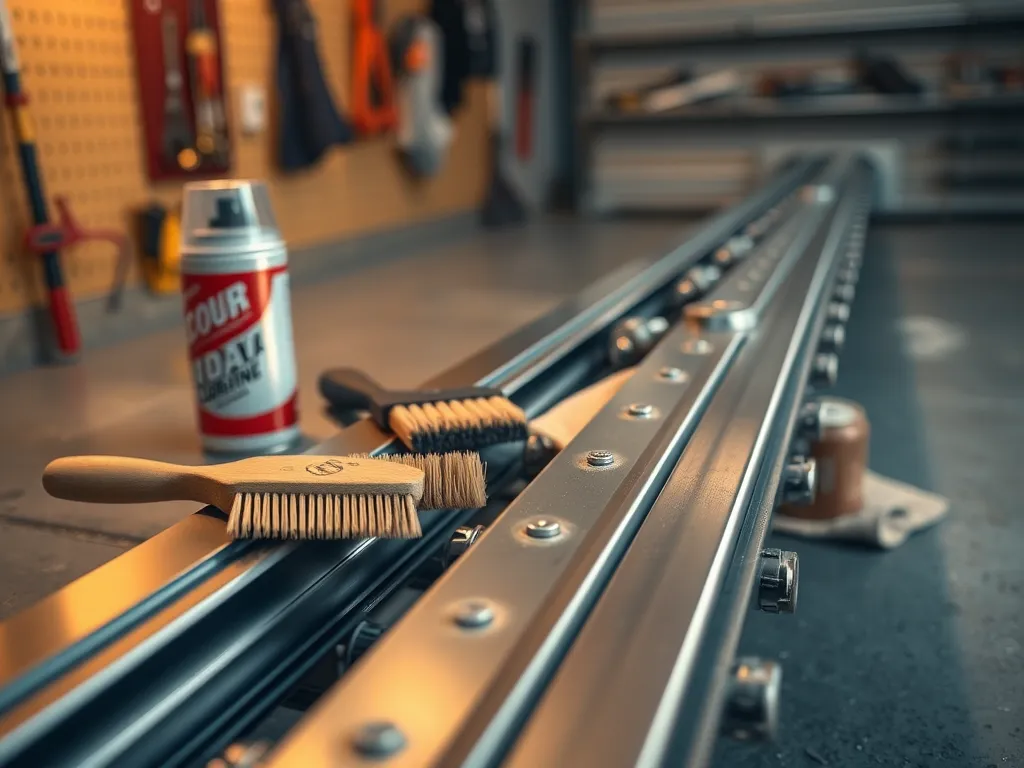Essential DIY Maintenance Tips for Garage Door Tracks & Rollers

DIY Maintenance for Garage Doors
Taking care of your garage door is essential to ensure its longevity and functionality. DIY maintenance for garage doors allows homeowners to identify and address issues before they turn into costly repairs. Regular inspections and maintenance not only help maintain safety but can also improve the overall efficiency of the door's operation.
One of the most important aspects of DIY maintenance for garage doors is routine inspections. This includes looking for signs of wear and tear, checking the tracks, rollers, and the overall condition of the garage door system. Being proactive in these inspections can save time, money, and effort over the long run.
Ensure your garage doors operate smoothly by following these essential roller cleaning steps regularly for optimal performance.
Another key component of DIY maintenance for garage doors is proper lubrication. This process is vital for ensuring that the moving parts operate smoothly. Regularly lubricating the tracks, rollers, and springs can greatly enhance performance and reduce noise, making your garage door work better and last longer.
In addition to lubrication and inspections, understanding safety measures during maintenance is crucial. Garage doors are heavy and can be dangerous if not handled correctly. Knowing how to safely perform maintenance, as well as understanding the mechanics involved, ensures a safer DIY experience.
For a comprehensive overview of how to maintain your garage doors effectively, refer to our detailed track inspection guide.
Overall, DIY maintenance for garage doors is an investment in your home that pays off. Regular maintenance not only extends the life of your garage door but also enhances its performance, ensuring it operates safely and efficiently for years to come.
Engaging in DIY maintenance can significantly extend the life of your garage doors, saving you time and money.
Garage Door Track Maintenance
Cleaning garage door tracks is a fundamental maintenance task that should be performed regularly. Use a damp cloth to wipe away dirt, debris, and any buildup that may hinder the door's movement. Avoid using harsh chemicals, as they can damage the track's surface.
For lubrication, utilize a silicone-based lubricant and apply it directly to the tracks. This ensures a smooth operation as the door moves. It’s best to avoid petroleum-based products, as they can attract dust and dirt, creating a gunky residue.
Misalignment of garage door tracks can cause significant issues. Regularly check the tracks for alignment by observing if the door moves evenly. If you notice gaps between the door and the tracks, adjust the brackets holding the tracks in place until they align properly.
Preventive measures include regularly inspecting the tracks for wear or damage, tightening loose screws, and ensuring that the mounting brackets are secure. Keep the area around the tracks clear of debris that may obstruct the movement of the garage door.
Signs that your tracks may need replacement include dents, rust, or if the door does not align properly even after adjustment. If tracks are severely damaged, consider professional replacement to ensure safety and functionality.
Roller Care and Replacement
Garage door rollers come in various types, including nylon, steel, and plastic. Nylon rollers are typically quieter and require less maintenance, while steel rollers are more durable but may create more noise. Selecting the right type depends on your priorities between noise and durability.
Inspect rollers for wear by checking for cracks, chips, or rough surfaces. Gently spin each roller; if they do not move freely or make noise, it’s likely time to consider replacing them. Pay attention to the overall condition of the roller as a key indicator of when maintenance is due.
To replace worn rollers, start by disconnecting the garage door opener, then raise the door manually to its highest position. Remove the existing roller from the track by unscrewing it, then install the new roller in the same position and reattach it securely.
Lubrication best practices for rollers involve applying silicone-based lubricant directly to the roller wheel and axles. Avoid over-lubricating as excess lubricant can attract dirt and debris, which can lead to premature wear.
When replacing rollers, ensure that they are compatible with your specific garage door tracks. Different types of rollers have varying diameters and features, so verifying compatibility is essential for smooth operation.
General Garage Door Maintenance
Routine checks for your garage door should happen at least once every season. This includes inspecting the springs, cables, tracks, and the overall function of the opener. Listen for unusual sounds and watch for any issues with the door's movement.
Common issues include sticking doors, uneven movement, or excessive noise. Troubleshooting these problems can often be done by cleaning and lubricating the parts or checking for misalignment. Regular maintenance can help prevent these issues from worsening.
Tools needed for DIY maintenance include a step ladder, screwdrivers, pliers, a socket wrench, a vacuum for cleaning tracks, a soft cloth, and appropriate lubricants like silicone spray.
Safety considerations during maintenance are paramount. Always disconnect the garage door opener and wear safety glasses to protect your eyes from debris. Make sure you have assistance if needed when working with heavy door components.
If you encounter issues beyond your skill level or if components are damaged beyond minor repairs, it’s important to call a professional. They have the expertise to safely handle complicated problems with garage doors.
Lubrication Techniques
The best lubricants for garage door components include silicone spray, lithium grease, and white lithium grease. Each lubricant has its benefits: silicone spray repels water, while lithium grease withstands high pressure and temperature.
How often to lubricate tracks and rollers varies, but a general rule is to lubricate every 3-6 months, or more frequently if you notice noise or sticking. Seasonal maintenance checks are a great reminder for lubrication needs.
DIY lubrication tips include using a clean cloth to wipe down components before application, ensuring they are dry and free of debris. Always apply lubricant sparingly to prevent buildup that can attract dust and dirt.
Common lubrication mistakes to avoid include using excessive amounts of lubricant, applying heavy grease instead of a lighter lubricant, and neglecting to clean parts before application. Taking care of these details will ensure optimal performance.
Environmental factors like humidity and temperature can affect lubrication needs. If you live in a humid environment, components may require more frequent lubrication. Always adjust your maintenance schedule according to weather conditions.
Safety Measures in Maintenance
Essential safety gear for DIY maintenance includes gloves to protect your hands from sharp edges, safety goggles to shield your eyes, and steel-toed boots in case heavy parts are dropped during maintenance.
Understanding garage door mechanisms is critical for safety. Familiarize yourself with how the springs, cables, and opener work together so you can properly troubleshoot and handle maintenance without risk of injury.
Emergency release procedures are vital to know. In case the garage door becomes stuck, locate the manual release cord, usually a red handle, and pull it to disengage the opener. Ensure the door is supported before handling it manually.
When handling heavy garage door parts, maintain proper lifting techniques to avoid injury. Ask for help if necessary, and never attempt to lift components that exceed your strength or size alone.
Maintaining child and pet safety around garage doors requires teaching them to stay clear of the door when in operation. Install eye sensors and an automatic reverse feature to reduce risks during door operation.
